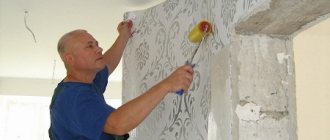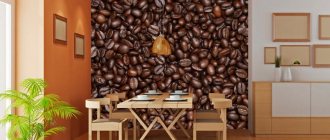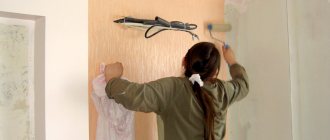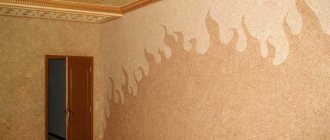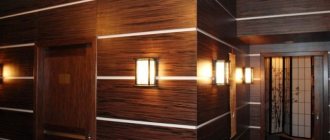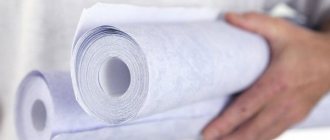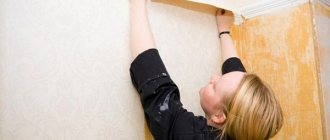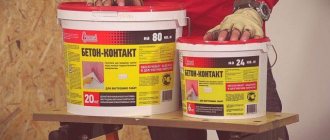In our dynamic information age, newspapers and magazines surround us everywhere. Bright covers and shocking headlines on them encourage us to buy a magazine or two, which will then forever “settle” in the bowels of the apartment. Attempts to get rid of newspapers and magazines are unlikely to be successful - before you have time to throw away the old ones, new ones will immediately be slipped into your mailbox, and so on, ad infinitum. In addition, many people collect magazines, however, over time, the collection grows so large that it leaves no room for its owner. We have found a way out of the vicious paper circle: to do this, you just need to correctly combine newspapers and your interior.
Why is this necessary?
In the distant Soviet past, people were accustomed to gluing newspaper strips instead of wallpaper, since not everyone could afford expensive wall coverings. Later they also began to be used as a backing for wallpaper, which was used mainly for leveling the surface of walls (how to level walls under wallpaper?).
Nowadays, newspapers have begun to enjoy some popularity again, but not as a source of information, but for the extravagant and original decoration of rooms. In this case, you can use ordinary newspapers made of thin paper, magazines, and other printed publications. On the building materials market you can even find wallpaper or photo wallpaper designed in a newspaper version .
Attention
Reference! This way of decorating rooms, according to many, will help preserve the memory of the passing time. Others consider this method of wall decoration an echo of the “newspaper boom”, which became popular thanks to the Italian designer P. Fornasetti, who came up with this theme more than 50 years ago.
Using newspapers to decorate walls is a practical, original solution . Firstly, it will get rid of excess waste paper in the house, and secondly, it will not require costs for new renovations in the apartment.
In order to choose the best wallpaper for yourself, we advise you to familiarize yourself with the types of wall coverings and learn how to glue non-woven, vinyl, embossed and photo wallpapers.
Basic techniques
In principle, all existing techniques for weaving from newspaper tubes completely repeat the work with willow vine, because, in fact, they are simply a more affordable substitute. The creation of complex elements and spectacular openwork patterns can be seen in numerous videos on the Internet. And we will present the most popular and simple techniques that even novice needlewomen can easily master here.
Concentric circles
An elementary method of weaving paper blanks for panels from newspaper tubes. The first one begins to be rolled into a tight “snail”, for reliability, coating its surface with a small amount of glue. The next vine is inserted with its narrow end inside the first, glued and wound further in a circle.
To fix the “snail”, if you need to take your mind off the panel or let the glue set, you can tie it across with a strip of fabric to prevent it from unwinding. In this way, many flat circles of different diameters are made, and then they are sewn together with strong threads in any order. The finished decoration can be covered with whatever your heart desires: herbarium, family photos or just beautiful pictures from decoupage cards.
Advice from craftswomen: before decorating, round “snail” blanks for panels need to be beaten with a hammer to get the most flat surface possible.
Donyshko
This is how the bottoms for baskets are woven, but this technique can also be used to make the same flat panel shapes. Work order:
- Lay 3 or 4 tubes on a flat surface in a “snowflake” pattern, crossing them at one point strictly in the center. For reliability, they can be glued to each other or secured with the tips on a cardboard mug. Place another blank under the crosshair with the butt and also secure it.
- Next we begin to weave the paper vine, making the same concentric circle out of it. In this case, the tube must be passed alternately from above and below the snowflake base.
- Gradually increase the working strip and continue weaving the web panel. If this technique is not easy for you, carefully look at photos on the Internet where baskets are woven from real vines.
As the diameter of the craft increases, additional weaving axes will have to be inserted. It is advisable to place them evenly - in the center of each sector. When the panel reaches the desired size, the protruding long ends are simply rolled inward and woven into the overall fabric.
Rope
Here, too, you should prepare a frame for the future panel, but it can already have any geometric shape. After this, each working tube is folded in half and clings to one of the guide beams, crosses and is circled on both sides around the next one. You will have to grow the vine more often and at both ends at once, so it is better to make the blanks longer. But you can weave a very neat and beautiful panel of any shape.
How to do it?
When you think of using newspapers as wallpaper, some may imagine a messy apartment during a renovation, where the walls are covered with old newspapers to prevent paint from getting on them.
But it is not necessary to cover the entire surface from floor to ceiling. You can use a more aesthetic method: use newspapers to cover a specific area in the house to achieve an unusual effect. You can create small original collages from newsprint that will become stylish wall decorations.
But newspaper strips as a design element must be combined with the rest of the apartment’s interior. It should be designed in the style of postmodernism. The newspaper theme can be continued in other elements of the decor, for example, in furniture.
What to add
The interior, in which the walls are decorated with such material, must be designed in a certain style. All details matter - furniture, household items and other finishing materials. As for the design of the floors and ceilings, here everyone chooses for themselves, as long as the color scheme and general style of the decor matches the walls, and you can experiment more seriously with interior items.
For example, if the walls are decorated with newspapers, then why not decorate the lampshades of the lamps in the same way? This will require minimal knowledge of decoupage techniques and source material. Such decoration will allow you to give a second life to items that have already served their purpose - old table lamps or lamps, turning them into a specific decorative object. Moreover, you can use decoupage to decorate furniture items - chests of drawers, tables or other furniture.
How to cover walls?
The technique of covering walls in this case is simple and unpretentious. To do this, you will need sufficient quantities of old newspaper issues and glue for paper wallpaper. You can even make and use a paste of potato or corn starch as an adhesive. To level the newspaper layers you will need a spatula and a roller. Any publication can be used as a wall covering.
- Newspapers are glued directly to the wall, which means that all its flaws and irregularities will appear through them. Therefore, it is better to glue them in advance with special paper or a layer of newspapers.
- Then an adhesive composition is applied to their reverse side. The newspaper sheet is immediately applied to the wall and smoothed with a roller. You can apply glue to the wall and then apply newspaper to it.
- Glue the sheets overlapping each other to obtain a seamless coating.
Advice
Attention! In order for such a coating to last a long time and not become dirty, it must be covered with a thin layer of water-based acrylic varnish, but only when everything is dry.
If the surface needs to be added moisture resistance, it can be coated with parquet varnish. It will create a kind of film on the wall, giving it an aesthetic, beautiful look.
Conclusion
Using newspapers to cover walls is a rather bold decision and requires a special approach. But, at the same time, this allows you to create an unusual and very attractive interior with minimal financial costs.
The only thing for the coating to be of high quality is to follow the above-described technology for pasting walls. Additional information on this topic can be obtained from the video in this article.
How to glue wallpaper onto newspaper strips?
Pasting newspaper strips under wallpaper is an effective method of wall decoration . This will ensure excellent adhesion of wallpaper and other decorative coatings to the surface. Newsprint swells when wet, eliminating some minor imperfections that would otherwise need to be filled with primer or putty.
- Before gluing the newspaper sheets, apply a layer of glue to the wall and leave it to dry.
- Then glue is applied on top again, newspaper is placed on it, and smoothed with a roller. It is impossible to spread a sheet of newspaper with prepared glue on the floor before gluing it, as it may tear.
- The wall is again left to dry for about a day.
- After the surface has dried, the wallpaper is carefully glued onto the newspaper base.
Wallpapering - rules and instructions
Probably of all types of repair work, gluing wallpaper on walls is the most common, which almost everyone has done at least once. Despite the general simplicity of the process, there are nevertheless some features and tricks that you need to know before starting work.
Preparing the base
The first step is to prepare the walls for wallpapering. They must be clean, leveled and uniformly plastered. The surface must be primed with one or two layers, such as acrylic primer, to strengthen the base and improve the wettability of the wall with glue. But don't overdo it with priming! Unlike preparing the surface for a self-leveling floor, where it is important that moisture is not absorbed into the thickness of the base at all, the walls should moderately absorb wallpaper glue. If the wall stops absorbing moisture, or, on the contrary, absorbs too much, then this equally leads to poor adhesion of the wallpaper to the wall and, in the best case, bubbles and peeling will appear after drying, and in the worst case, the wallpaper will simply fall off even at the drying stage.
If thin paper or non-woven wallpaper is chosen, then the base should be painted in a uniform (preferably white) color. That is, if the wall, for example, is concrete and some irregularities on it are covered with plaster or putty, then after wallpapering these places will show through the wallpaper in spots. Therefore, when carrying out plastering work, it is necessary to bring the color of the walls to a uniform appearance. Read more about preparing walls for applying the finishing coating in the material “Preparation of walls and ceilings before applying the finishing coating.”
Until recently, it was customary to glue a rough layer of old newspapers under the wallpaper. This was done, firstly, to level the walls, which in Soviet-built houses were far from perfect, and secondly, newspapers acted as a primer, because priming the walls with starch glue alone was insufficient and without a layer of newspapers the wallpaper simply fell off.
When purchasing rolls, you should choose from one batch (the number is indicated on each package), since even with very perfect printing in different batches, rolls may differ slightly in saturation and color, and this difference will be noticeable.
Further actions are directly dependent on the selected type of wallpaper. Instructions for gluing are included in each roll.
Wallpaper is glued either end-to-end or overlapping. The glue is applied either to the wallpaper or to the wall, or both are spread.
The work will require a special plastic spatula for smoothing the wallpaper on the wall and a roller for tightly rolling the edges. But you can do it the old fashioned way with a foam sponge or rag.
If the wallpaper is not glued end-to-end to the ceiling, but some kind of edging is implied, then it is necessary to first apply markings along the perimeter under the ceiling. For marking, it is best to use a water level (two flasks connected by a long hose) and a marking cord. Then, from this strictly horizontal line, you need to use a plumb line or square to draw a vertical guide along which the first sheet of wallpaper will be pasted.
The wallpaper is cut so that it starts at the top of the prepared line and goes underneath the baseboard. The excess can be cut off immediately after gluing or after drying with a sharp knife along a ruler.
If glue is applied to wallpaper, then after application the wallpaper should be allowed to lightly soak in the glue. To do this, if space allows, the wallpaper is folded in half with the adhesive layer inward, and if there is a problem with free space, then the spread sheet should be folded like an accordion, without making sharp bends.
Manufacturing
Although the newspaper finishing material is monotonous, it cannot be transformed in any way , there are 5 ways to use it:
- You can cover the entire wall with it.
- Select a zone in the room with newspaper wallpaper (read about why space zoning is needed and how to achieve it using finishing materials).
- Create a panel.
- Make a collage or composition from newspaper clippings.
- Decorate both wall panels and any interior element, for example, a bookshelf, cabinet, table and others.
Important
One of the original design methods is making liquid wallpaper from waste newspapers. Its main advantage is its ease of preparation. The material is very cheap, it is available to everyone.
Difficulties of repairs in the USSR
Modern renovation and renovation that was done in the Union are two very big differences. If now the stores are full of all kinds of materials and tools for every taste, then previously, due to the large shortage, it was not easy to purchase something. That is why at that time most people in their apartments had not only the same furniture, but also wallpaper of the same color and texture.
And the process of wallpapering walls at that time was not as simple as it is now, and it was the same for everyone. For example, wallpaper glue was boiled. Yes, they really cooked it on a very ordinary stove. There were no adhesive compositions, especially in such an assortment as now, for sale in hardware and construction stores.
Repair, whether in Russia or in the USSR, is always a “natural disaster”
They used ordinary starch: it was diluted in water and boiled, turned into a paste. In some cases, even flour was used. This glue held regular paper wallpaper well on the walls, but it took an extremely long time to dry. And due to the long drying period and high humidity, the wallpaper lost its appearance - it bubbled, slid, etc. If newspapers were previously glued to the walls, then such welded glue would set faster, and the wallpaper would stick better than on bare plaster. And there were fewer unsightly bubbles, unevenness and cracks.
On a note! The main disadvantage of using such a composition for gluing wallpaper is the high risk that bugs and cockroaches will settle in the paper layers, considering the paste an excellent food.
Photo
Next in the photo you can see how you can paste over the walls, and how newspapers pasted instead of wallpaper will look in the interior.
Why else do they glue newspaper under wallpaper?
Several layers of newspaper hid the defects. In addition, the glue dried faster between the newspaper and the wallpaper. However, these are not all the advantages of such a “primer”.
Oddly enough, newspapers increased the life of plaster. Walls without a printed layer crumbled faster. Along with the plaster, the new wallpaper came off. But even on strong walls, the wallpaper did not fit properly. Without impregnation and a durable backing, sooner or later the wallpaper began to “slip.” The room took on an unkempt and uncomfortable appearance.

